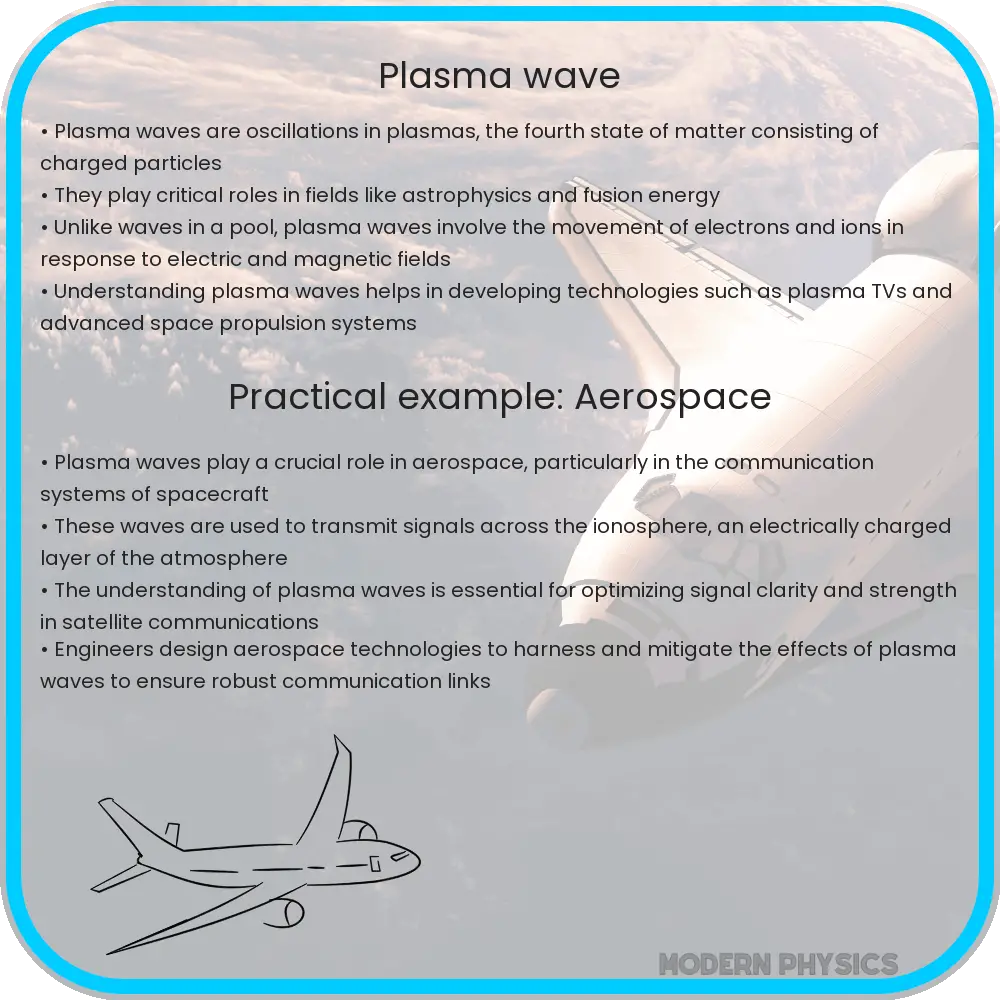Explore the dynamics of plasma waves, their theoretical foundations, and diverse applications in astrophysics, fusion energy, and beyond in this insightful article.

Introduction to Plasma Waves
Plasma waves, a fundamental concept in plasma physics, play a pivotal role in understanding the dynamics and behavior of plasmas, the fourth state of matter. These waves occur within a plasma when electric and magnetic fields interact with charged particles, leading to oscillations that propagate through the plasma. This interaction is crucial for numerous applications, ranging from astrophysical phenomena to practical applications in industry and fusion energy research.
Basics of Plasma Wave Dynamics
At its core, plasma wave theory describes how waves and instabilities develop in a plasma. Unlike waves in a neutral gas, plasma waves are governed by the collective behavior of its charged particles under the influence of electromagnetic forces. Two primary types of waves are identified in plasma: electrostatic and electromagnetic. Electrostatic waves are characterized by oscillations in the electric field that do not propagate as electromagnetic waves, while electromagnetic plasma waves involve the oscillation of both electric and magnetic fields, allowing them to propagate through space.
Key Theoretical Concepts
- Langmuir Waves: These are high-frequency electrostatic oscillations in plasmas, driven by the electric field created by the movement of electrons.
- Magnetohydrodynamic (MHD) Waves: These waves occur in magnetized plasmas and are crucial in understanding phenomena such as solar flares and the dynamics of the Earth’s magnetosphere. MHD waves include Alfvén waves, which propagate along magnetic field lines.
- Ion Acoustic Waves: These are low-frequency waves that propagate through the ions in a plasma, with the electron pressure providing the restoring force.
Applications of Plasma Waves
Plasma waves are not just theoretical constructs but have practical applications across various fields. In astrophysics, they provide insights into the behavior of the sun and other celestial bodies. In the realm of controlled nuclear fusion, understanding plasma waves is crucial for stabilizing the plasma within fusion reactors, a key challenge for harnessing fusion as a clean energy source. Additionally, plasma wave technology finds applications in materials processing, telecommunications, and space propulsion systems, demonstrating the wide-ranging impact of these phenomena.
Advanced Dynamics and Instabilities
The study of plasma waves also delves into complex dynamics and instabilities that can influence the behavior of a plasma. For example, the Kelvin-Helmholtz instability occurs at the interface between two fluid layers with different velocities, relevant in both astrophysical and laboratory plasmas. Similarly, the Rayleigh-Taylor instability, which happens when a denser fluid is accelerated into a less dense fluid, plays a significant role in inertial confinement fusion and supernova explosions. Understanding these instabilities is crucial for controlling plasma behavior in applications like fusion reactors and predicting cosmic phenomena.
Diagnosing Plasmas with Waves
One of the most practical applications of plasma waves is in plasma diagnostics. Techniques such as Langmuir probe diagnostics and microwave interferometry rely on the interaction between plasma waves and electromagnetic fields to measure plasma properties like density, temperature, and ionization states. These diagnostic tools are indispensable in both research and industrial applications, allowing scientists and engineers to “see” into plasmas and understand their properties without directly interacting with the high-temperature plasma.
Future Directions in Plasma Wave Research
The field of plasma wave research is continually evolving, with new discoveries and applications emerging regularly. One area of intense research is in the optimization of plasma wave interactions for efficient energy transfer in fusion reactors. Similarly, the development of plasma-based accelerators presents a promising avenue for high-energy physics, potentially enabling more compact and affordable particle accelerators. Additionally, understanding plasma waves is increasingly important in space exploration, for protecting spacecraft from solar wind and in the design of advanced propulsion systems.
Conclusion
Plasma waves encompass a vast and dynamic field of study that bridges theoretical physics and practical applications. From elucidating the fundamental processes governing the universe to enabling groundbreaking technologies on Earth, the study of plasma waves is at the forefront of scientific discovery and innovation. As researchers continue to unravel the complexities of plasma behavior, the potential for new applications and technologies based on plasma wave dynamics appears limitless. The journey through the fascinating world of plasma waves not only enhances our understanding of the universe but also paves the way for future advancements in science and technology.
